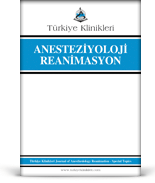Amaç: Çalışmamızın amacı, ultrasonografi kullanılarak (USG) açılan perkütan dilatasyonel trakeostomi (PDT) ile fiberoptik bronkoskopi kullanarak (FOB) açılan PDT'nin işlem süresi ve komplikasyonlarını karşılaştırmaktır. Gereç ve Yöntemler: Çalışmamıza uzun süreli mekanik ventilasyon ihtiyacı olan erişkin hastalar dâhil edildi. Hastalar, USG ile açılan PDT (Grup I, n=30) ve FOB ile açılan PDT (Grup II, n=30) olarak prospektif, randomize olarak 2 gruba ayrıldı. Tüm hastaların demografik verileri ile birlikte yoğun bakıma yatış nedeni, hemogram, kan gazı değerleri, trakeostomi açılma süresi, işlem sırasında ve sonrasındaki komplikasyonları kaydedildi. Bulgular: Çalışmamızda, USG veya FOB yöntemi ile otuzar olmak üzere toplam 60 hastaya PDT açıldı. Gruplar arası trakeostomi açılma süresinde fark gözlenmedi (p=0,883). Her iki grup içi SpO2 değerlerindeki düşüş istatistiksel olarak anlamlıydı (sırasıyla p=0,004 p=0,002). Grup içinde PaO2 değerlerindeki düşüş istatistiksel olarak anlamlıydı (sırasıyla p=0,006, p=0,011). Trakeostomi için en yaygın endikasyon nörolojik hastalıklardı (Grup I: %36,7, Grup II: %43,3), ardından solunum sistemi ve multi travma hastalarına PDT açıldı. İşlem sonrası komplikasyon olarak en fazla minör kanama (Grup I: %13,3, Grup II: %10) görüldü. Stoma çevresinde kanama bunu takip etti (Grup I: %10, Grup II: %10). Sonuç: USG rehberliğinde ve bronkoskopi eşliğinde PDT açılması, havayolu yönetiminde hızlı ve güvenilir yöntemlerdir. Yöntem tercihi klinisyenin deneyimi ve kliniğin imkânlarına göre belirlenebilir.
Anahtar Kelimeler: Ultrasonografi; trakeostomi; bronkoskopi
Objective: The aim of our study is to compare the procedural time and complications of ultrasonography (USG) guided percutaneous dilatational tracheostomy (PDT) with fiberoptic bronchoscopy (FOB) guided PDT. Material and Methods: Adult patients, required long-term mechanical ventilation were included in our study. Patients were prospectively, randomly assigned into 2 groups as PDT with USG (Group I, n=30), and PDT with FOB (Group II, n=30). Patients' demographic datas, the reason for admission to intensive care unit, hemogram, blood gas values, tracheostomy opening time, complications during and after the procedure were recorded. Results: A total of 60 adult patients were included in the study, 30 patients in USG group and 30 patients in FOB group. There was no difference in tracheostomy opening time between the groups (p=0.883). The decreases in SpO2 values within the group were statistically significant in both groups (p=0.004, p=0.002, respectively). The decreases in PaO2 values within the group were statistically significant (p=0.006, p=0.011, respectively). The most common indication for tracheostomy was neurological diseases (Group I: 36.7%, Group II: 43.3%), followed by PDT in respiratory system and multi-trauma patients. The most common postoperative complication was minor bleeding (Group I: 13.3%, Group II: 10%). Bleeding around the stoma was the second common complication (Group I: 10%, Group II: 10%). Conclusion: Ultrasoundguided and bronchoscopy-guided PDT are fast and reliable methods in airway management. The choice of method can be determined according to the clinician's experience and the clinic's facilities.
Keywords: Ultrasonography; tracheostomy; bronchoscopy
- Durbin CG Jr. Tracheostomy: why, when, and how? Respir Care. 2010;55(8):1056-68. [PubMed]
- Griggs WM, Worthley LI, Gilligan JE, Thomas PD, Myburg JA. A simple percutaneous tracheostomy technique. Surg Gynecol Obstet. 1990;170(6):543-5. [PubMed]
- Al-Ansari MA, Hijazi MH. Clinical review: percutaneous dilatational tracheostomy. Crit Care. 2006;10(1):202. [Crossref] [PubMed] [PMC]
- Rajajee V, Fletcher JJ, Rochlen LR, Jacobs TL. Real-time ultrasound-guided percutaneous dilatational tracheostomy: a feasibility study. Crit Care. 2011;15(1):R67. [Crossref] [PubMed] [PMC]
- Peris A, Linden M, Pellegrini G, Anichini V, Di Filippo A. Percutaneous dilatational tracheostomy: a self-drive control technique with video fiberoptic bronchoscopy reduces perioperative complications. Minerva Anestesiol. 2009;75(1-2):21-5. [PubMed]
- Plata P, Gaszyński T. Ultrasound-guided percutaneous tracheostomy. Anaesthesiol Intensive Ther. 2019;51(2):126-32. [Crossref] [PubMed]
- Rees J, Haroon Y, Hogan C, Saha S, Derekshani S. The ultrasound neck imaging for tracheostomy study: a study prompting ultrasound screening prior to percutaneous tracheostomy procedures to improve patient outcomes. J Intensive Care Soc. 2018;19(2):107-13. [Crossref] [PubMed] [PMC]
- Gupta S, Tomar DS, Dixit S, Zirpe K, Choudhry D, Govil D, et al. Dilatational percutaneous vs surgical tracheostomy in intensive care unit: a practice pattern observational multicenter study (DISSECT). Indian J Crit Care Med. 2020;24(7):514-26. [Crossref] [PubMed] [PMC]
- Karasu D, Yılmaz C, Baytar Ç, Korfalı G. Yoğun bakım ünitemizde perkütan yöntemle açılan trakeostomi olgularının retrospektif analizi [Retrospective analysis of percutaneous tracheostomi cases in intensive care unit]. Turk J Intensive Care. 2018;16:83-7. [Crossref]
- Kırca H, Çakın Ö, Cengiz M, Yılmaz M, Ramazanoğlu A. Yoğun bakımda trakeotomi: endikasyonlar, komplikasyonlar ve prognoz [Tracheotomy in the intensive care unit: indications, complications and prognosis]. J Turk Soc Intensive Care. 2018;16:17-25. [Crossref]
- Iftikhar IH, Teng S, Schimmel M, Duran C, Sardi A, Islam S. A network comparative meta-analysis of percutaneous dilatational tracheostomies using anatomic landmarks, bronchoscopic, and ultrasound guidance versus open surgical tracheostomy. Lung. 2019;197(3):267-75. [Crossref] [PubMed]
- Eminoğlu Ş, Özgünay Ş. Fiberoptik bronkoskopiyle açılan perkütan dilatasyonel trakeostomi ile standart perkütan dilatasyonel trakeostominin karşılaştırılması: prospektif, randomize çalışma [Comparison of percutaneous dilatational tracheostomy via fiberoptic bronchoscopywith standard percutaneous dilatational tracheostomy: a prospectiverandomized trial]. Med Bull Haseki. 2020;58:78-83. [Crossref]
- Gobatto ALN, Besen BAMP, Tierno PFGMM, Mendes PV, Cadamuro F, Joelsons D, et al. Ultrasound-guided percutaneous dilational tracheostomy versus bronchoscopy-guided percutaneous dilational tracheostomy in critically ill patients (TRACHUS): a randomized noninferiority controlled trial. Intensive Care Med. 2016;42(3):342-51. [Crossref] [PubMed]
- Ravi PR, Vijay MN. Real time ultrasound-guided percutaneous tracheostomy: is it a better option than bronchoscopic guided percutaneous tracheostomy? Med J Armed Forces India. 2015;71(2):158-64. [Crossref] [PubMed] [PMC]
- Song J, Xuan L, Wu W, Zhu D, Zheng Y. Comparison of percutaneous dilatational tracheostomy guided by ultrasound and bronchoscopy in critically ill obese patients. J Ultrasound Med. 2018;37(5):1061-9. [Crossref] [PubMed]
- Gobatto ALN, Besen BAMP, Cestari M, Pelosi P, Malbouisson LMS. Ultrasound-guided percutaneous dilational tracheostomy: a systematic review of randomized controlled trials and meta-analysis. J Intensive Care Med. 2020;35(5):445-52. [Crossref] [PubMed]
- Kost KM. Endoscopic percutaneous dilatational tracheotomy: a prospective evaluation of 500 consecutive cases. Laryngoscope. 2005;115(10 Pt 2):1-30. [Crossref] [PubMed]
- Saritas A, Saritas PU, Kurnaz MM, Beyaz SG, Ergonenc T. The role of fiberoptic bronchoscopy monitoring during percutaneous dilatational tracheostomy and its routine use into tracheotomy practice. J Pak Med Assoc. 2016;66(1):83-9. [PubMed]







.: Process List